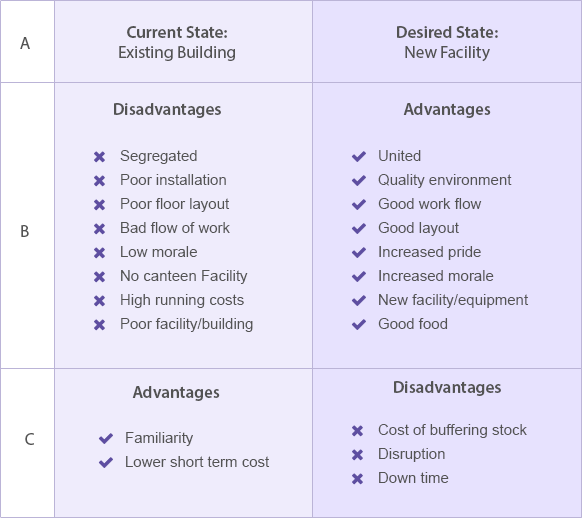Resistance to Change (The ABC Technique)
This is a simple, but elegant, method, devised by Finn Tschudi, (1977) that provides a very useful framework for identifying why people don’t change or what may stop them from embracing change. The model looks at the meaning applied by the individual on the change, what they see as its benefits, the downside and implications resulting from changing.
In many ways it is similar to the four key coaching questions used in NLP (what will you get if you get it, what won’t you get, what will you get if you don’t get it and what won’t you get) and looks to get at the underlying resistances to change.
However, in my opinion, it is presented in a more accessible way for both client and consultant.
The model can best be described as a way of looking at the current situation, the desired (or new situation) and then identifying the advantages and disadvantages of if them both!
So you first identify the current and desired situations (A). Then you, in effect, brainstorm or list all the negative things associated with the current situation and all the positive things you’ll get by moving to the new situation or behaviour (B).
Finally, and to my mind the most powerful part of the model, you identify all the things you’ll either be loosing by moving and/or all the negative associations with moving. You then look at what, if any, positives do you get from the current situation, what are the good things about the here and now, what do you get from carrying on as normal, etc. (C).
Once you have completed your lists you can then start to analyse the answers with your client. You are looking for potential blockers to change. You need to start exploring relative values and weightings of these blockers and decide how to overcome them.
If row C contains anything that is more important than row B the person will resist changing! This allows you to manage the change process and overcome the blockers.
You can also get clients to “score” each of the comments and rate them for importance. This gives you some idea of those show-stoppers and those which might be quick hits to resolve.
Hopefully, in order to help make sense of the technique, below is a “worked example” that I’ve used in the past to help bring the model to life. This is an amalgamation from a couple of change management sessions where groups looked at outsourcing some of their work to a new facility in the Philippines.
As you can see from the list below, there are some issues that have been identified that need addressing before the change would be successful and work. These reasons may explain why people do not adopt the change.
However, and probably more importantly, they may not have come up with any of their objections at all if, as is usual with a lot of change management tools, the focus of the consultant had been on the advantages of moving and the disadvantages of staying the same (as identified in row B). change plans are then built round these and Row C is, at best, part of the risk plan if acknowledged at all!

Source:
Tschudi F. (1977), Loaded and Honest Questions, in Bannister D (ed), New Perspectives in Personal Construct Theory, Academic Press, London
